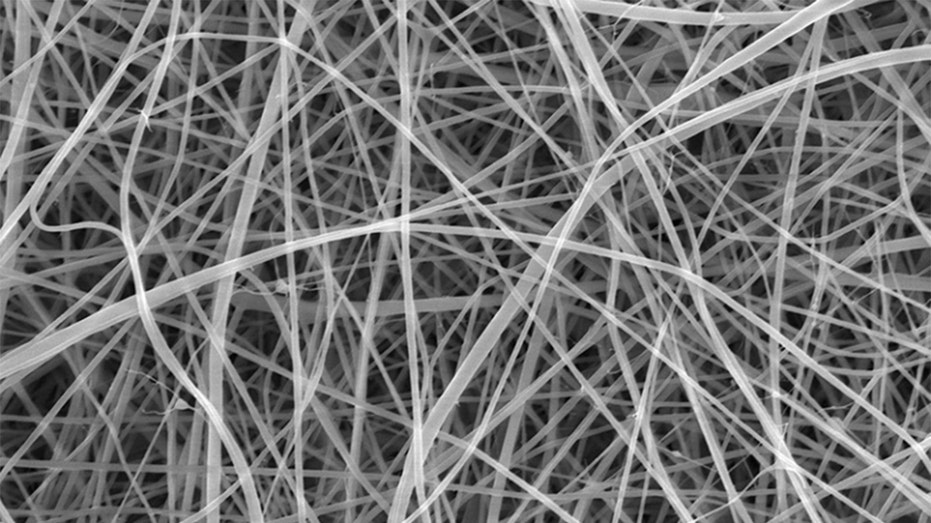
Scientists have created the world’s thinnest spaghetti – though diners should not be expecting to find it on their plates any time soon. Or ever.
This “nanopasta” was created as part of an experiment at University College London, the school said in a recent news release.
Unlike traditional pasta, the nanopasta is neither edible nor meant to be eaten — although it is made of flour and water.
STEAK ‘N SHAKE TO COOK FRIES IN BEEF TALLOW: ‘AUTHENTIC WAY’
While spaghetti, angel hair and similar pasta types are normally made with either an extruder or specialized kitchen tool, the method of creating nanopasta was similar – but on a much, much smaller scale.
“To make spaghetti, you push a mixture of water and flour through metal holes. In our study, we did the same, except we pulled our flour mixture through with an electrical charge,” Adam Clancy, a lecturer in Inorganic and Materials Chemistry at University College London, said in a news release.
The scientists made the “pasta” as a way to test the viability of using starch to create nanofibers.
These nanofibers have the potential to be used in wound dressings or in other medical settings, said UCL School of Pharmacy Professor Gareth Williams in a release.
“In addition, nanofibers are being explored for use as a scaffold to regrow tissue, as they mimic the extracellular matrix – a network of proteins and other molecules that cells build to support themselves,” he said.
CLICK HERE TO SIGN UP FOR OUR LIFESTYLE NEWSLETTER
The starch nanofibers have advantages over other materials, Clancy noted.
“Starch is a promising material to use, as it is abundant and renewable – it is the second-largest source of biomass on Earth, behind cellulose. And it is biodegradable, meaning it can be broken down in the body,” Clancy said in the release.
Starch, however, “requires a lot of processing” before it can be purified.
This nanopasta, he said, is proof there is a “simpler way” to make these fibers.
“The next step would be to investigate the properties of this product. We would want to know, for instance, how quickly it disintegrates, how it interacts with cells and if you could produce it at scale,” he said.
For more Lifestyle articles, visit www.foxnews.com/lifestyle
The nanopasta is 372 nanometers in diameter, a thousand times thinner than the next-thinnest pasta in the world.
That pasta, called “su filindeu,” is 400 microns wide and is handmade in Sardinia, according to the release.
The scientists created a 2-centimeter-sized “mat” of nanofibers, which is the only way these objects could be seen.
The individual strands, however, are too small to be seen without the aid of a scanning electron microscope, according to the release. They are also too thin to be able to ever conceivably cook, researchers said.
While angel hair pasta – the thinnest variety of pasta that’s widely available – takes four minutes to cook in boiling water, nanopasta would be done even faster.
Nanopasta would “overcook in less than a second, before you could take it out of the pan,” Williams said.
Scientists have created the world’s thinnest spaghetti – though diners should not be expecting to find it on their plates any time soon. Or ever.
This “nanopasta” was created as part of an experiment at University College London, the school said in a recent news release.
Unlike traditional pasta, the nanopasta is neither edible nor meant to be eaten — although it is made of flour and water.
STEAK ‘N SHAKE TO COOK FRIES IN BEEF TALLOW: ‘AUTHENTIC WAY’
While spaghetti, angel hair and similar pasta types are normally made with either an extruder or specialized kitchen tool, the method of creating nanopasta was similar – but on a much, much smaller scale.
“To make spaghetti, you push a mixture of water and flour through metal holes. In our study, we did the same, except we pulled our flour mixture through with an electrical charge,” Adam Clancy, a lecturer in Inorganic and Materials Chemistry at University College London, said in a news release.
The scientists made the “pasta” as a way to test the viability of using starch to create nanofibers.
These nanofibers have the potential to be used in wound dressings or in other medical settings, said UCL School of Pharmacy Professor Gareth Williams in a release.
“In addition, nanofibers are being explored for use as a scaffold to regrow tissue, as they mimic the extracellular matrix – a network of proteins and other molecules that cells build to support themselves,” he said.
CLICK HERE TO SIGN UP FOR OUR LIFESTYLE NEWSLETTER
The starch nanofibers have advantages over other materials, Clancy noted.
“Starch is a promising material to use, as it is abundant and renewable – it is the second-largest source of biomass on Earth, behind cellulose. And it is biodegradable, meaning it can be broken down in the body,” Clancy said in the release.
Starch, however, “requires a lot of processing” before it can be purified.
This nanopasta, he said, is proof there is a “simpler way” to make these fibers.
“The next step would be to investigate the properties of this product. We would want to know, for instance, how quickly it disintegrates, how it interacts with cells and if you could produce it at scale,” he said.
For more Lifestyle articles, visit www.foxnews.com/lifestyle
The nanopasta is 372 nanometers in diameter, a thousand times thinner than the next-thinnest pasta in the world.
That pasta, called “su filindeu,” is 400 microns wide and is handmade in Sardinia, according to the release.
The scientists created a 2-centimeter-sized “mat” of nanofibers, which is the only way these objects could be seen.
The individual strands, however, are too small to be seen without the aid of a scanning electron microscope, according to the release. They are also too thin to be able to ever conceivably cook, researchers said.
While angel hair pasta – the thinnest variety of pasta that’s widely available – takes four minutes to cook in boiling water, nanopasta would be done even faster.
Nanopasta would “overcook in less than a second, before you could take it out of the pan,” Williams said.



